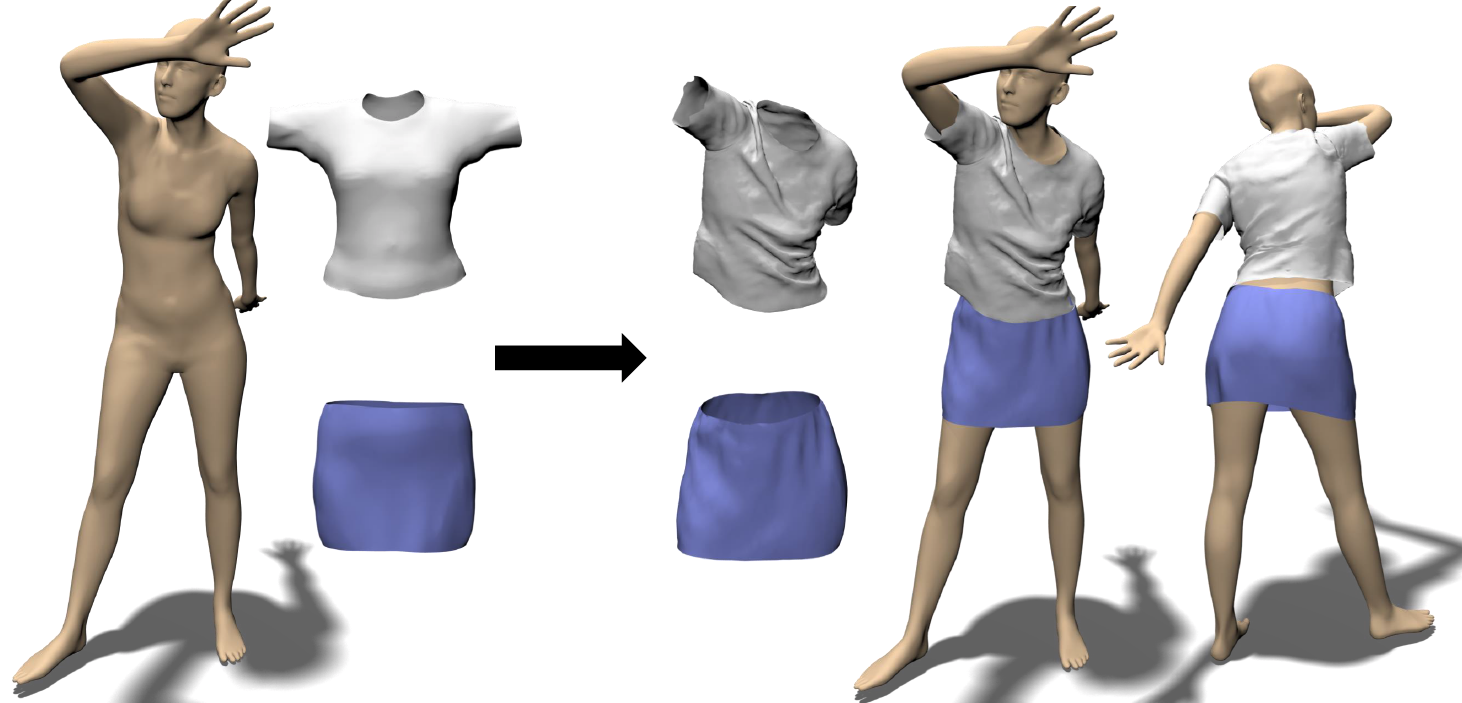chaitanya100100 / Tailornet
Programming Languages
Projects that are alternatives of or similar to Tailornet
TailorNet
This repository contains training and inference code for the following paper:
TailorNet: Predicting Clothing in 3D as a Function of Human Pose, Shape and Garment Style
Chaitanya Patel*, Zhouyingcheng Liao*, Gerard Pons-Moll
CVPR 2020 (ORAL)
[ArXiv] [Project Website] [Dataset Repo] [Oral Presentation] [Results Video]
Citation
Cite us if you use our model, code or data:
@inproceedings{patel20tailornet,
title = {TailorNet: Predicting Clothing in 3D as a Function of Human Pose, Shape and Garment Style},
author = {Patel, Chaitanya and Liao, Zhouyingcheng and Pons-Moll, Gerard},
booktitle = {{IEEE} Conference on Computer Vision and Pattern Recognition (CVPR)},
month = {jun},
organization = {{IEEE}},
year = {2020},
}
Updates
- [26-12-2020] Female skirt weights added.
- [11-11-2020] Female and male short-pant weights added.
- [02-08-2020] Female and male pant weights added.
- [19-07-2020] Male shirt weights added.
- [12-07-2020] Female shirt weights added.
- [28-06-2020] Female t-shirt weights added.
- [25-06-2020] Minor bug fixes and male t-shirt weights added.
- [17-06-2020] Inference script and female old-t-shirt weights added.
Requirements
python3
pytorch
scipy
chumpy
psbody.mesh
How to Run
- Download and prepare SMPL model and TailorNet data from dataset repository.
- Set DATA_DIR and SMPL paths in
global_var.pyfile accordingly. - Download trained model weights in a directory and set its path to MODEL_WEIGHTS_PATH variable in
global_var.py.- old-t-shirt_female_weights (4.1 GB)
- t-shirt_male_weights (2.0 GB)
- t-shirt_female_weights (2.0 GB)
- shirt_female_weights (2.5 GB)
- shirt_male_weights (2.5 GB)
-
This link has all the weights listed above as well as the following:
- pant_female_weights
- pant_male_weights
- short-pant_female_weights
- short-pant_male_weights
- skirt_female_weights
- Set output path in
run_tailornet.pyand run it to predict garments on some random inputs. You can play with different inputs. You can also run inference on motion sequence data. - To visualize predicted garment using blender, run
python run_tailornet.py render. (Blender 2.79 needs to be installed.)
TailorNet Per-vertex Error in mm on Test Set
... evaluated using evaluate function in utils/eval.py.
| garment_class | gender | TailorNet Baseline | TailorNet Mixture Model |
|:--:|:--:|:--:|:--:|
| old-t-shirt | female | 11.1 | 10.7 |
| t-shirt | female | 12.6 | 12.3 |
| t-shirt | male | 11.4 | 11.2 |
| shirt | female | 14.2 | 14.1 |
| shirt | male | 12.7 | 12.5 |
| pant | female | 4.7 | 4.8 |
| pant | male | 8.1 | 8.1 |
| short-pant | female | 6.8 | 6.6 |
| short-pant | male | 7.0 | 7.0 |
| skirt | female | 7.7 | 7.8 |
Training TailorNet yourself
- Set global variables in
global_var.py, especially LOG_DIR where training logs will be stored. - Set config variables like gender and garment class in
trainer/base_trainer.py(or pass them via command line) and runpython trainer/base_trainer.pyto train TailorNet MLP baseline. - Similarly, run
python trainer/lf_trainer.pyto train low frequency predictor andtrainer/ss2g_trainer.pyto train shape-style-to-garment(in canonical pose) model. - Run
python trainer/hf_trainer.py --shape_style <shape1>_<style1> <shape2>_<style2> ...to train pivot high frequency predictors for pivots<shape1>_<style1>,<shape2>_<style2>, and so on. SeeDATA_DIR/<garment_class>_<gender>/pivots.txtto know available pivots. - Use
models.tailornet_model.TailorNetModelwith appropriate logdir arguments to do prediction.
Inference Time
In the paper, we report inference time to be 1-2 ms per frame(depending upon garment) which is averaged inference time over the batch of 21 samples(20-40 ms per batch). Apologies for the ambiguity. Running each sample separately takes almost same time as batch - around 20 ms per frame for all garments. However, note that TailorNet has 21 independent MLPs, so we believe that faster inference time is possible if MLPs are configured to run in parallel on GPU cores.
Misc
- See ./models/skirt_model.md for the explanation of skirt garment model.
- Thanks to Bharat for many fruitful discussions and for
smpl_liblibrary taken from his MultiGarmentNet repo's lib folder. - Thanks to Garvita for helping out during the onerous procedure of data generation.
For any doubt or concert about the code, raise an issue on this repository.

